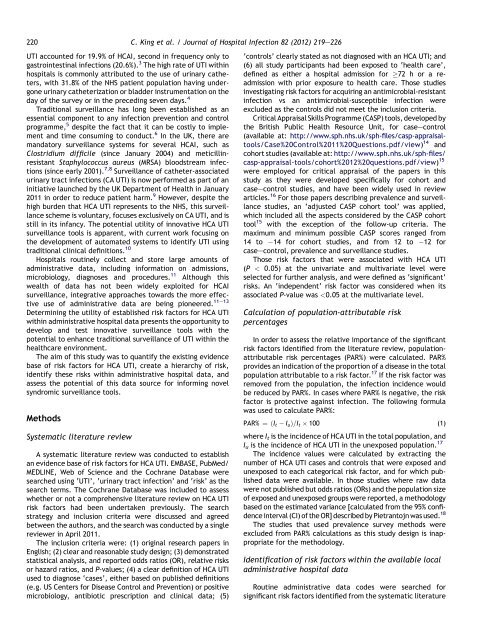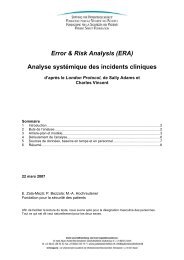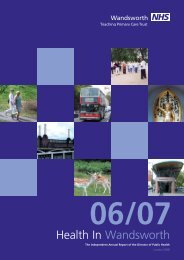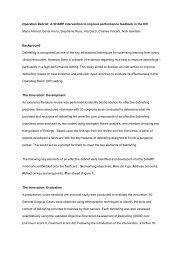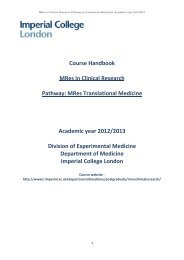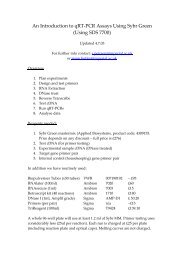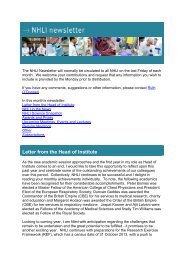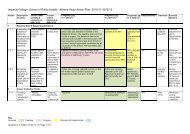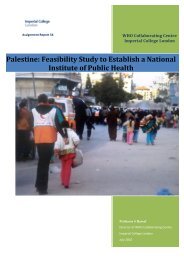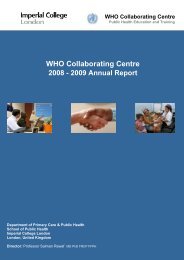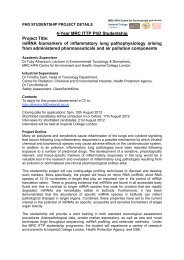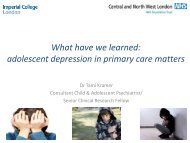220UTI accounted <strong>for</strong> 19.9% of HCAI, second in frequency only togastrointestinal <strong>infection</strong>s (20.6%). 3 The high rate of UTI withinhospitals is commonly attributed to the use of <strong>urinary</strong> catheters,with 31.8% of the NHS patient population having undergone<strong>urinary</strong> catheterization or bladder instrumentation on theday of the survey or in the preceding seven days. 4Traditional surveillance has long been established as anessential component to any <strong>infection</strong> prevention <strong>and</strong> controlprogramme, 5 despite the fact that it can be costly to implement<strong>and</strong> time consuming to conduct. 6 In the UK, there arem<strong>and</strong>atory surveillance systems <strong>for</strong> several HCAI, such asClostridium difficile (since January 2004) <strong>and</strong> meticillinresistantStaphylococcus aureus (MRSA) bloodstream <strong>infection</strong>s(since early 2001). 7,8 Surveillance of catheter-<strong>associated</strong><strong>urinary</strong> <strong>tract</strong> <strong>infection</strong>s (CA UTI) is now per<strong>for</strong>med as part of aninitiative launched by the UK Department of Health in January2011 in order to reduce patient harm. 9 However, despite thehigh burden that HCA UTI represents to the NHS, this surveillancescheme is voluntary, focuses exclusively on CA UTI, <strong>and</strong> isstill in its infancy. The potential utility of innovative HCA UTIsurveillance tools is apparent, with current work focusing onthe development of automated systems to identify UTI usingtraditional clinical definitions. 10Hospitals routinely collect <strong>and</strong> store large amounts ofadministrative data, including in<strong>for</strong>mation on admissions,microbiology, diagnoses <strong>and</strong> procedures. 11 Although thiswealth of data has not been widely exploited <strong>for</strong> HCAIsurveillance, integrative approaches towards the more effectiveuse of administrative data are being pioneered. 11e13Determining the utility of established risk <strong>factors</strong> <strong>for</strong> HCA UTIwithin administrative hospital data presents the opportunity todevelop <strong>and</strong> test innovative surveillance tools with thepotential to enhance traditional surveillance of UTI within the<strong>healthcare</strong> environment.The aim of this study was to quantify the existing evidencebase of risk <strong>factors</strong> <strong>for</strong> HCA UTI, create a hierarchy of risk,identify these risks within administrative hospital data, <strong>and</strong>assess the potential of this data source <strong>for</strong> in<strong>for</strong>ming novelsyndromic surveillance tools.MethodsSystematic literature reviewA systematic literature review was conducted to establishan evidence base of risk <strong>factors</strong> <strong>for</strong> HCA UTI. EMBASE, PubMed/MEDLINE, Web of Science <strong>and</strong> the Cochrane Database weresearched using ‘UTI’, ‘<strong>urinary</strong> <strong>tract</strong> <strong>infection</strong>’ <strong>and</strong> ‘risk’ as thesearch terms. The Cochrane Database was included to assesswhether or not a comprehensive literature review on HCA UTIrisk <strong>factors</strong> had been undertaken previously. The searchstrategy <strong>and</strong> inclusion criteria were discussed <strong>and</strong> agreedbetween the authors, <strong>and</strong> the search was conducted by a singlereviewer in April 2011.The inclusion criteria were: (1) original research papers inEnglish; (2) clear <strong>and</strong> reasonable study design; (3) demonstratedstatistical analysis, <strong>and</strong> reported odds ratios (OR), relative risksor hazard ratios, <strong>and</strong> P-values; (4) a clear definition of HCA UTIused to diagnose ‘cases’, either based on published definitions(e.g. US Centers <strong>for</strong> Disease Control <strong>and</strong> Prevention) or positivemicrobiology, antibiotic prescription <strong>and</strong> clinical data; (5)C. King et al. / Journal of Hospital Infection 82 (2012) 219e226‘controls’ clearly stated as not diagnosed with an HCA UTI; <strong>and</strong>(6) all study participants had been exposed to ‘health care’,defined as either a hospital admission <strong>for</strong> 72 h or a readmissionwith prior exposure to health care. Those studiesinvestigating risk <strong>factors</strong> <strong>for</strong> acquiring an antimicrobial-resistant<strong>infection</strong> vs an antimicrobial-susceptible <strong>infection</strong> wereexcluded as the controls did not meet the inclusion criteria.Critical Appraisal Skills Programme (CASP) tools, developed bythe British Public Health Resource Unit, <strong>for</strong> caseecontrol(available at: http://www.sph.nhs.uk/sph-files/casp-appraisaltools/Case%20Control%2011%20Questions.pdf/view)14 <strong>and</strong>cohort studies (available at: http://www.sph.nhs.uk/sph-files/casp-appraisal-tools/cohort%2012%20questions.pdf/view) 15were employed <strong>for</strong> critical appraisal of the papers in thisstudy as they were developed specifically <strong>for</strong> cohort <strong>and</strong>caseecontrol studies, <strong>and</strong> have been widely used in reviewarticles. 16 For those papers describing prevalence <strong>and</strong> surveillancestudies, an ‘adjusted CASP cohort tool’ was applied,which included all the aspects considered by the CASP cohorttool 15 with the exception of the follow-up criteria. Themaximum <strong>and</strong> minimum possible CASP scores ranged from14 to 14 <strong>for</strong> cohort studies, <strong>and</strong> from 12 to 12 <strong>for</strong>caseecontrol, prevalence <strong>and</strong> surveillance studies.Those risk <strong>factors</strong> that were <strong>associated</strong> with HCA UTI(P < 0.05) at the univariate <strong>and</strong> multivariate level wereselected <strong>for</strong> further analysis, <strong>and</strong> were defined as ‘significant’risks. An ‘independent’ risk factor was considered when its<strong>associated</strong> P-value was
C. King et al. / Journal of Hospital Infection 82 (2012) 219e226 221review in order to address the utility of administrative hospitaldata <strong>for</strong> the development of surveillance tools.Imperial College Healthcare NHS Trust (ICHNT) is one of thelargest NHS hospital groups in the UK, consisting of five hospitalswith 1540 beds <strong>and</strong> one central laboratory. Over 750 localdatabases have been identified within ICHNT, 11 comprisinga mixture of small departmental datasets, surveillance <strong>and</strong>larger trust-wide systems. Data on patient demographics,diagnoses [International Classification of Diseases Version 10(ICD-10)], 19 operations <strong>and</strong> procedures (OPCS), <strong>and</strong> admission<strong>and</strong> discharge data are stored in the large organization-widepatient administration system (PAS). Microbiology <strong>and</strong> laboratorydata are located in the laboratory in<strong>for</strong>mation managementsystem (LIMS), <strong>and</strong> further in<strong>for</strong>mation on antimicrobialprescribing <strong>and</strong> <strong>infection</strong> prevention <strong>and</strong> control is located inlocally per<strong>for</strong>med surveillance.A comprehensive variable list <strong>and</strong> code book of the hospitaldata available <strong>for</strong> this study was created <strong>and</strong> cross-checkedagainst the list of ex<strong>tract</strong>ed risk <strong>factors</strong> <strong>for</strong> UTI. Keywordsearches of the ICD-10 codes were per<strong>for</strong>med, based on the listof HCA UTI risk <strong>factors</strong> identified during the literature review,using the World Health Organization’s online search tool(http://apps.who.int/classifications/icd10). A Microsoft Excel(2007) reference spreadsheet was generated. ICD-10 codesidentified from any included studies were also recorded on thereference spreadsheet. The process was repeated with operation<strong>and</strong> procedure codes <strong>and</strong> pathology codes using referencedatabases provided by ICHNT.In order to use hospital data <strong>for</strong> research, ethical approvalwas granted by St. Mary’s National Research Ethics Committee<strong>for</strong> the use of administrative hospital data from ICHNT in ananonymized <strong>for</strong>mat, i.e. one way anonymization <strong>and</strong> removalof all patient-identifiable fields prior to data analysis (Ref. No.:09/H0712/85).ResultsThe systematic literature search returned 4109 uniquepapers. One percent were excluded <strong>for</strong> not being in English,89% had titles that were not relevant to the study question, <strong>and</strong>6% were excluded as irrelevant after abs<strong>tract</strong> review. Theresults retrieved from the Cochrane Database returned norelevant studies. In total, 154 studies underwent full-textreview <strong>and</strong> 23 were ultimately included in the study(Figure 1). Of the 23 papers included, three papers werecaseecontrol studies, 20e22 13 papers were cohort studies, 23e35six papers were surveillance <strong>and</strong> prevalence studies, 4,36e40 <strong>and</strong>one paper used data derived from a large r<strong>and</strong>omizedcontrolled trial database (Table I). 41The majority of studies were per<strong>for</strong>med in high-incomesettings, of which two were based in the UK. 4,22 Threestudies were undertaken in the middle-income countries ofBrazil, 24 India 23 <strong>and</strong> Egypt. 39 Two studies 23,34 involved paediatricpopulations, with the remaining 21 papers addressingadult populations, including patients from generalwards, 4,20,22,26,28,36,37,39,41 patients in intensive care units(ICUs), 29e31,33,38,40 surgical patients, 35 stroke patients, 32orthopaedic patients, 27 hip fracture admissions, 21 spinalinjury patients 25 <strong>and</strong> renal transplant patients. 24The CASP scores <strong>for</strong> the three caseecontrol studies rangedfrom nine 22 to six, 20 whilst the prevalence studies, using theadjusted CASP cohort study tool, scored between five 4,37 <strong>and</strong>Title not relevant:3668Not English: 44Criteria not met: 13134 – lacking statistics60 – inappropriate cases/controls37 – not original researchInitial search: 4109Abs<strong>tract</strong> review: 441Full-text review: 154Abs<strong>tract</strong> notrelevant: 243Included:23Figure 1. Systematic literature review schematic. The numbersrepresent the number of studies at each stage (e.g. 441 studiesunderwent abs<strong>tract</strong> review).11 36 out of 12. The cohort studies scored between three 38 <strong>and</strong>13 35 out of 14. Of the 23 papers included, almost 80% hada CASP value within the score’s upper quartile, being six <strong>and</strong>above <strong>for</strong> the caseecontrol, prevalence <strong>and</strong> surveillancestudies, <strong>and</strong> seven <strong>and</strong> above <strong>for</strong> the cohort studies.Of the 143 risk <strong>factors</strong> assessed in all the studies, 96 (68%)were significant <strong>and</strong> 43 were independent risk <strong>factors</strong> <strong>for</strong> HCAUTI, with six studies not per<strong>for</strong>ming multivariate analyses. Ofthe independent risk <strong>factors</strong>, 29 were only assessed by onestudy. Among the remaining 14 risk <strong>factors</strong> that were assessedby multiple studies, half were found to be significant in morethan one of the studies in which they were included (femalesex, increasing age, diabetes mellitus, length of hospital stay,prior stroke, <strong>urinary</strong> catheter <strong>and</strong> duration of <strong>urinary</strong> catheter).Female sex was included in all the papers <strong>for</strong> analysis <strong>and</strong>was found to be significant in 65% of the studies. One-quarter ofthe independent risk <strong>factors</strong> were <strong>associated</strong> with <strong>urinary</strong>catheter use <strong>and</strong> management, including colonization of thedrainage bag, 41 having more than two catheters recorded 20 <strong>and</strong>intermittent catheterization. 22In order to assess the relative importance of the significantrisk <strong>factors</strong> <strong>for</strong> HCA UTI, PAR% values were calculated <strong>for</strong> those<strong>factors</strong> where sufficient data were reported in the correspondingstudies. Raw data (as described in the Methods) wereex<strong>tract</strong>ed directly from 14 studies, while ORs were used toobtain raw data in four studies. 25,33e35 Two studies did notpublish sufficient data to enable PAR% calculations, 27,40 <strong>and</strong>three papers were not included as these were prevalencestudies. 4,36,37 Thus, 18 of the 23 papers contributed data to thePAR% calculations. PAR% values were calculated <strong>for</strong> 35 significantrisk <strong>factors</strong> <strong>for</strong> HCA UTI, <strong>and</strong> 26 were also independent risk<strong>factors</strong>. The remaining 17 independent risk <strong>factors</strong> did not havesufficient data <strong>for</strong> PAR% calculations.


